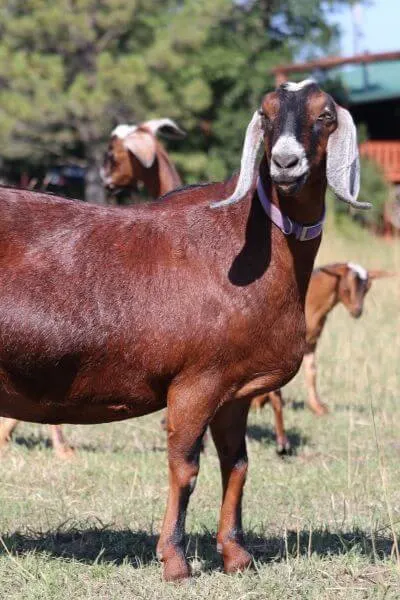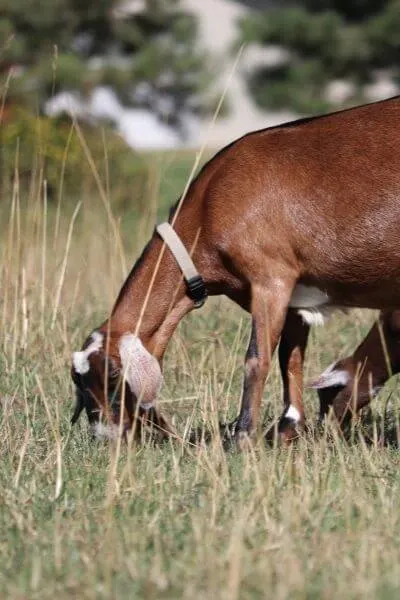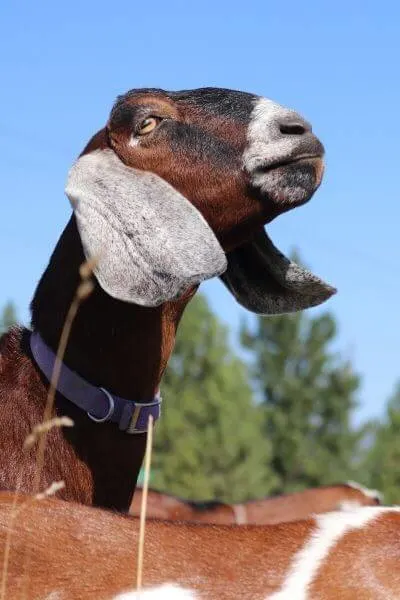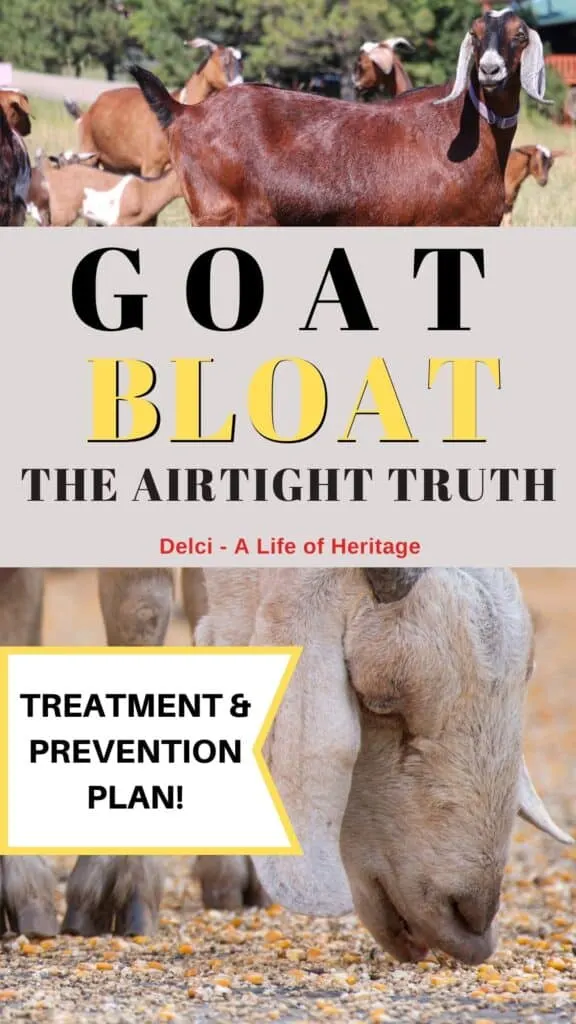Goat bloat is a serious condition. Do you know what causes it, what it looks like, and how to treat it? Below you’ll get a detailed break about this very important subject…
It was a happy, blue sky kind of morning. I smiled as I rounded the corner of the house and heard my guineas stirring up quite a racket in the hayfield. Goofy birds.
It was one of those mornings that felt so good, spring after a long winter always put life back into my body and soul. The air had the slight chill of the night but the sun was quickly warming up my corner of the earth. It felt so good.
But my heart skipped a beat and panic rushed through my veins when I saw Kira…stuffed into the corner of our little goat shelter. She wasn’t in her usual position…demanding to be fed. As my eyes took in the situation, they finally landed on the open door to the barn.
I dropped my milk bucket and the clank echoed as it landed and rolled. I ran to the barn and yanked out all the goats with their heads in the bags of feed.
“Who left the door open??” I was fuming. I was desperately looking for someone to blame. It could have been the kids…but it was probably me. “I always double-check the barn door when I leave! How could it be open??” I was in a dither. “Oh, you goats, you should know better! Don’t you know any better?? You should know when to stop for goodness sake!”
A full treatment and prevention plan for bloat is available as a bonus in My Goat Binder. It has the complete list of ingredients for a special potion for poisoning that causes frothy bloat and vomiting. This is a must-have in your goat management and is included in the goat management binder.
Watch the Goat Bloat Video below…or Continue reading…
If you like this information, my YouTube channel is full of even more goat information. Please click this link: Delci | A Life of Heritage and subscribe! You can also click this link to watch this information on YouTube: Goat Bloat Video on YouTube
My goat Kira, the leader of the herd, had Ruminal Acidosis and was bloated. Bloat in Goats can also be called ruminal tympany.
At the time, I didn’t know much about bloat.
But now I know that there are two main types of bloat: Frothy Bloat and Choke Bloat
Frothy Bloat
Frothy bloat is caused by a build-up of gases in the rumen. This trapped air starts to put pressure on the heart and lungs. And left untreated, will end in death.
Causes of Frothy Bloat in goats
Frothy bloat can be caused by a number of different issues. One common one is goats getting into the barn where the grain is kept (even after you KNOW you locked it up tight.)
If you like to know all the juicy details about a subject like I do, then this will fascinate you. When a goat chews food their mouths produce something called bicarbonate. If your goats are eating hay or are in the pasture browsing all the lovely broadleaf plants they adore and eating the pasture grass available, they are chewing a lot. Which means there is a lot of bicarbonate being produced and consumed. This is a good thing!
But if they are eating grain, especially grain that is highly ground up, or they have an affinity to wolfing down their grain without chewing, they are producing very little or no bicarbonate. Or if they consume too much grain in one sitting, the bicarbonate can’t keep up. This is where the problems begin.
This is one reason it is a good idea to have fresh baking soda available for your goats at all times, especially in confined situations. The goats that you and I own are not in their natural environments and need our help providing them with things that will help keep them healthy. They “self-medicate” when their body says they need the baking soda and it helps to regulate the delicate balance of their rumen.
Bloat can also happen in the spring when the fresh, fast-growing, green grass is tempting the goats after a long winter on dry hay. Switching a goat’s diet too quickly can have drastic consequences. During the spring, it is so important to transition to pasture slowly. This will prevent bloat if your goats consume too much lush grass when their rumen can’t handle it. You can read more about transitioning goats to pasture in this article about what goats eat.
To sum up frothy bloat, it can be caused by these things:
- Consuming too much grain
- Consuming too much grass when their rumen isn’t used to it
Choke Bloat (Free gas bloat)
Choke bloat is caused by something, an obstruction, being caught in the throat of the goat.
Causes of Choke Bloat or Free Gas Bloat in goats
There are a number of ways a goat can get choked up. It could be carrot pieces, apples, or even grain.
Other causes
If your goat is sick and you don’t think it was anything mentioned so far, then you may also consider these causes as well:
- Kids fed milk replacers, as opposed to real goat milk, are at risk for bloat
- Uncured, wet, and moldy hay consumed in excess will cause problems
- Some weeds, especially milkweed, will imbalance the rumen
- Sudden changes in diet; giving too much new food, too fast
- Overeating foods that produce lots of gas over short periods
- Overeating in general
- Paralysis of the face (like with Tetanus)
Bloat vs Hay Belly
If you have a goat with a large belly, you, or visiting friends, may wonder if your goat has bloat, is fat, or is ready to kid any day. A healthy goat, with a low worm load, and a large belly actually is a good sign. It means that they have a large rumen and that’s a good thing!
But if they are continually eating because they are feeding a large number of parasites inside their digestive system, then they will develop a hay belly. Be sure to check for signs of anemia and keep your goat’s worm load under control.
How to tell the difference between hay belly and bloat
If your goat has a hay belly, they won’t act sick and display the symptoms of bloat as shown below. When you push on the left side of a goat, where their rumen is located, their hay belly will be squishy and may make an indent in the rumen if you were to push on it. The indent will stay in place after you remove your hand.
But with bloat, the goat will have a tight belly, filled with trapped air. A tympani is a drum played in an orchestra. Your goat’s belly will be tight as a drum, thus bloat being referred to as Ruminal Tympany.
Signs of Goat Bloat
When you walk into your goat pen, you may or may not be able to immediately see if your goat is bloated. Your goat may be found in the corner of the barn, and away from the other goats and only when they stand up, do you recognize their air-filled rumen.
When Kira was sick after her grain binge, I found her alone, standing up in the corner of our goat pallet shelter. I knew immediately that something was wrong just by looking at her.
- She was alone.
- She had drooping ears and sad eyes.
- And when I got up closer to her, her lips were pursed together in pain.
- Her belly was full and filled with air.
You may also notice these signs of bloat:
- restlessness (Kira was shifting back and forth on her feet)
- noticeable abdominal discomfort
- loss of appetite
- increased salivation
- distended left side
- bitting or kicking at the abdomen
- respiratory distress
- collapse
- death
Treatment of Goat Bloat
I’m so thankful I was able to get to Kira as quickly as I did. Timing does matter and it’s important to act as quickly as possible to treat your sick goat.
As laid out in My Goat Binder, you want to assess the symptoms and the surroundings first. Go through the symptom checker, take your goat’s temperature and then begin the treatment.
My Goat Binder has this full treatment plan laid out to follow, including a treatment potion that isn’t included in this article.
Treatment Option One
You may notice that it is advised to get a stomach tube down your goat and administer mineral oil. But without experience doing this, it can be very tricky and nerve-wracking to know if you are in the right location to give the mineral oil. If the stomach tube ended up in the lungs, your goat will die a very painful death due to the oil ending up in the lungs and not the stomach.
But without the stomach tube, giving mineral oil to goats is dangerous. Mineral oil doesn’t have any taste so goats can’t tell when to swallow and can easily aspirate it. Give your goats vegetable or peanut oil instead.
If you do not have experience with a stomach tube, do not attempt this or call your vet for help and assistance. If the goat can swallow and you are very careful to give small swallows at a time with a drenching gun, vegetable or peanut oil will help your goat out immensely.
Treatment Option Two
Another option is to use a trochar to release the trapped gas. A trochar is a metal tube (similar to a needle) that punctures the rumen and releases the trapped gas through a tube. If it came down to it and you had a 14 or 16-gauge needle, you could puncture the rumen with the needle to release the gas as well. DO THIS ONLY IF IT IS THE LAST OPTION AND INVOLVE YOUR VET IF POSSIBLE. There are risks involved but if it’s a last-ditch effort, then it’s worth trying.
Treatment Option Three
Use this option if your goat is well enough and able to swallow.
With great care given, slowly give the goat small squirts of vegetable or peanut oil so they can swallow it.
If the goat were to ASPIRATE this into their lungs, they are at risk of getting pneumonia from the foreign substance in their lungs
Administer orally 1/4 – 1/3 cup of vegetable/peanut oil.
Mineral oil is a tasteless substance and goats can’t tell when they need to swallow. it is advised not to use mineral oil.
And no matter what anyone says, DO NOT use Tide as a treatment plan in any way, shape, or form. The Tide of today is not the Tide of the 1970s and is a poison. Do not give it to your goats ever.
Next Steps of Goat Bloat Treatment
When a goat is bloated, they stop eating and drinking. They feel sick! If they aren’t drinking, they are getting dehydrated.
Dehydration can bring on a whole new set of problems so it is really important to rehydrate your goat. Use a very large syringe or a drenching gun and drench electrolytes (carefully) down their throat.
It is easier if you have two people for this if possible. One person can stand over the goat and hold under their chin with the mouth tilted up to the sky, while the other person carefully drenches the electrolytes into their mouth. Position the tip of the syringe or the drench gun so that it is touching the inside of their cheek. This helps them to swallow easier without choking.
A full treatment and prevention plan for bloat is available as a bonus in My Goat Binder. It has the complete list of ingredients for a special potion for poisoning that cases frothy bloat and vomiting. This is a must-have in your goat management and is included in the goat management binder.
After you have given your goat the oil, intermittently walk them around and then massage their left side where the rumen is located. This will help break up the air bubbles. Do this until they start to burp and fart.
Prevention
Oh prevention, how we love thee. Prevention is incredibly important. None of us want to go out to the goat pen and find a wreck. So, what can you do to prevent your goats from getting bloated?
Here are a few goat bloat prevention steps:
- Gradually introduce your goats to pasture in the springtime.
- Give them hay before letting them out to pasture so they have a full tummy and don’t gorge on the green grass.
- Avoid feeding grains and concentrates that are finely-ground.
- Feed hay before giving your goats grains or concentrates.
- If you have an aggressive goat that doesn’t chew grain and just swallows it, spread it out over a large area to reduce the risk of grain choke.
- Keep all grains in bins that lock or close tightly.
- Keep all doors locked that lead to grain bins (and then check and double-check and even triple-check that it’s actually locked).
- Don’t feed goats shelled corn. It may be cheap but it’s “candy” to goats and not good for them. not only nutritionally but they will overload their systems with it any chance they can get.
- Make changes to your goat’s diet carefully and slowly. They have very sensitive rumens.
- When bringing new goats home, ask what they were being fed. If the goat is being fed grain (if you can) ask for a small bag of feed from the seller so that you can slowly transition during the next week over to the grain you use. Or, if you don’t have a grain picked out and can purchase the same kind of grain, do that.
A good ending…will your ending be the same?
Kira made a full recovery, thankfully. She still looks for any opportunity she can to get into the grain, silly girl. I guess she didn’t learn her lesson after all.
But I did! and I’m so thankful I have a treatment and prevention plan printed out and laminated in My Goat Binder. Be sure to get yours mailed right to you so you can be prepared for anything and record everything! Get this goat management binder to make record-keeping easy.
You are organized. You are knowledgeable. You are proactive. This is how. Click below to get this binder in your hands to avoid common errors that affect your goat's health. These records are your freedom and your goat's optimal health.Goat Essential ↓
Goat Management Binder
Read more: Goat Bloat Overview, Ruminal Acidosis, Bloat in Goats





Kristina
Saturday 4th of July 2020
I left the bottle babies to bed down around 9:30 p.m. Same routine, same bottle, NOTHING different, nor was there access to anything different as I put them in a contained pen at night. Early a.m. the next morning I went out to feed them and she was dead, completely unexpected! No marks on her, but her little tummy looked like a small basketball. I'm assuming bloat? She just turned a month old, playing and acting fine the night before. I was back out there 8 hours later. Her mama was a Silky Fainter, dad a Kiko/Nubian. As a new goat owner who was being SUPER careful, I'm STILL traumatized! What could have possibly gone wrong? Any ideas? I do NOT want to have to experience that again.
Delci Plouffe
Thursday 6th of August 2020
I'm so sorry this happened. It's really hard to tell from my vantage point. Sometimes pneumonia can act quickly as well if she wasn't bloated. One thing that is really helpful after something like that happens is to have a necropsy done. It will give you the full picture of what went wrong inside and can help give you answers. I know that doesn't' help now and hopefully it doesn't ever happen again.